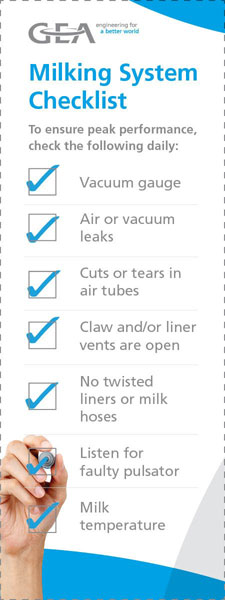With today’s milk prices, you’re likely trying to find new places to save money on your dairy. While you work to tighten your farm’s belt, regular maintenance of the milking system is an area of your budget to protect.
“For your herd to perform at its peak, your milking system must also run at peak performance,” says Keith Engel, GEA dairy farm hygiene and supplies specialist. “Farms often cut milking system maintenance for short-term savings. However, this cut can end up causing long-term financial challenges. For example, replacing a vacuum pump can cost thousands of dollars compared to hundreds of dollars for timely repairs.”

Here are some tips to help keep your milking system maintenance in check:
1. Make a maintenance schedule
Work with your milking equipment dealer to create a master schedule of all milking equipment maintenance needs. Start with the manufacturer’s recommendations for maintenance frequency, then adjust according to your farm’s performance history.
“Remember, it’s not necessarily the number of days that determine how often maintenance should be performed – it’s the hours of run time. A parlor that runs 24-hours-a-day needs maintenance more often than one running for 12 hours,” says Engel.
As you implement a maintenance schedule, maintain a log including maintenance date and name or initials of the person who completed the maintenance.
2. Stay aware day-to-day
“Your preventative maintenance schedule should also extend to daily awareness. By being more diligent, it will help your equipment last longer,” says Engel.
Complete the following checks before every milking:
- Milking vacuum level
- Air or vacuum leaks
- Cuts or tears in air tubes
- Claw and/or liner vents are open
- No twisted liners or milk hoses
- Listen for faulty pulsator
- Milk temperature
When washing starts, do a walkthrough of all milking units, meters and sensors. Make sure no leaks exist, water is flowing properly through all the parts and the air injector is working.
3. Keep in-between maintenance checks in place
Between scheduled maintenance, allow your milking equipment dealer to check the vacuum, graph pulsators and evaluate takeoffs during milking.
“It’s helpful to monitor equipment function through your performance data, such as milk flow rate and quality counts,” says Engel. “Keep tabs on bacteria counts, laboratory pasteurized count and other bacteria counts. They can identify problems with sanitation early.”
You can also mark chemical barrels to ensure they are dispensing consistently during cleaning and sanitation.
4. Avoid emergency calls
“At the end of the day, you want to avoid emergency calls,” says Engel. “They are expensive and often result in lost money and time you would rather be spending with family or doing other activities. Cows never like an interruption in their milking time either.”
No matter how tempting it may be to hold back, even when milk prices are low, it pays to protect your investment in equipment with regular, scheduled care and maintenance.
“If you do that long enough, you will not only realize savings, you will have a recorded history and know what it takes to get the highest quality production and performance from your dairy. You will also be able to create the optimal service intervals for your farm,” says Engel.
Work with your equipment specialists and technicians to ensure your equipment is working correctly and to schedule regular maintenance. For more information contact your local GEA sales representative or contact GEA at 877-WS-Dairy (877-973-2479).
GEA is one of the largest suppliers of process technology for the food industry and a wide range of other industries. The international technology group focuses on process technology and components for sophisticated production processes in various end-user markets. In 2017, GEA generated consolidated revenues of about EUR 4.6 billion. The food and beverages sector, which is a long-term growth industry, accounted for around 70 percent. The company employs almost 18,000 people worldwide. GEA is a market and technology leader in its business areas. The company is listed on the German MDAX stock index (G1A, WKN 660 200) and included in the STOXX® Europe 600 Index. In addition, the company is listed in selected MSCI Global Sustainability Indexes. Further information is available at gea.com.

